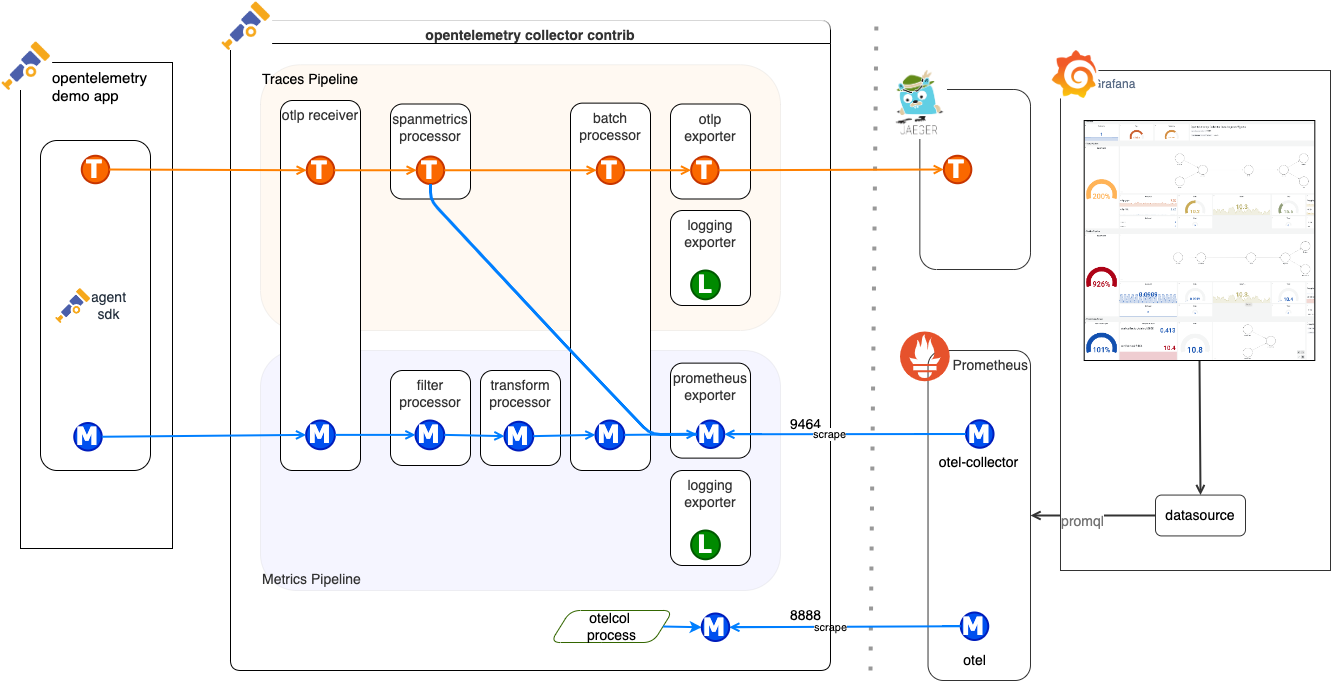I provide more detailed explanation of this tutorial.
How was the architecture of this tutorial designed?
OpenTelemetry offers a demo that can install both a microservice called the Astronomy Shop, which is configured to extract telemetry data, and OpenTelemetry Collector which are set up to collect and expose this telemetry data. You can explore the demo in more detail via this link.
Thus, the primary focus of this PR is to inject chaos into the cart and recommendation microservices of the Astronomy Shop and then observe the results of these experiments. To be simply, we just added LitmusChaos to the demo that OpenTelemetry already provided.
How is the telemetry data instrumented in this tutorial?
The following instrumentation method diagram provides a detailed explanation of how telemetry data is instrumented in each microservice of the Astronomy Shop. Also, you can check the coverage of logs, metrics, and traces for each microservice of the Astronomy Shop through log coverage link, metric coverage link, and trace coverage link.
Instrumentation method diagram for each microservice
Service | Language | Description | Instrumentation -- | -- | -- | -- accountingservice | .NET | Processes incoming orders and count the sum of all orders (mock/). | Automatic Instrumentation adservice | Java | Provides text ads based on given context words. | Automatic Instrumentation, Manual Instrumentation cartservice | .NET | Stores the items in the user’s shopping cart in Redis and retrieves it. | Instrumentation Libraries, Manual Instrumentation checkoutservice | Go | Retrieves user cart, prepares order and orchestrates the payment, shipping and the email notification. | Instrumentation Libraries, Manual Instrumentation currencyservice | C++ | Converts one money amount to another currency. Uses real values fetched from European Central Bank. It’s the highest QPS service. | Manual Instrumentation emailservice | Ruby | Sends users an order confirmation email (mock/). | Instrumentation Libraries, Manual Instrumentation frauddetectionservice | Kotlin | Analyzes incoming orders and detects fraud attempts (mock/). | Instrumentation Libraries frontend | JavaScript | Exposes an HTTP server to serve the website. Does not require sign up / login and generates session IDs for all users automatically. | Instrumentation Libraries, Manual Instrumentation paymentservice | JavaScript | Charges the given credit card info (mock/) with the given amount and returns a transaction ID. | Manual Instrumentation productcatalogservice | Go | Provides the list of products from a JSON file and ability to search products and get individual products. | Instrumentation Libraries, Manual Instrumentation quoteservice | PHP | Calculates the shipping costs, based on the number of items to be shipped. | Instrumentation Libraries, Manual Instrumentation recommendationservice | Python | Recommends other products based on what’s given in the cart. | Automatic Instrumentation, Manual Instrumentation shippingservice | Rust | Gives shipping cost estimates based on the shopping cart. Ships items to the given address (mock/). | Instrumentation Libraries, Manual InstrumentationHow does OpenTelemetry Collector collect and expose telemetry data in this tutorial?
In this tutorial, telemetry data is collected by OpenTelemetry and stored in the Jaeger & Prometheus Backend according to the following data flow diagram.

In more detail, this OpenTelemetry Collector uses the OTLP Receiver, Prometheus Receiver, HTTPCheck/FrontendProxy Receiver, and Redis Receiver as receivers. Especially, the Prometheus Receiver is collecting chaos metrics exposed through the chaos exporter.
If you are also interested in the configurations for the exporters and processors of the OpenTelemetry Collector, you can refer to this code.
Lastly, I fully support the documentation for this tutorial. :)
Proposed changes
This pull request introduces a tutorial on injecting chaos into the target application, otel-demo, using Litmus, and then collecting and observing the application's logs, metrics (including chaos metrics), and tracing through OpenTelemetry. The otel-demo consists of microservices written in various programming languages that communicate over gRPC and HTTP, along with a load generator that uses Locust to simulate user traffic. By following this tutorial, users will gain observability into both the chaos experiments and the target application. This tutorial aims to help users enhance their understanding of how chaos engineering can be integrated with observability practices to improve system resilience.
Tutorial Architecture
Tutorial Summary
Types of changes
What types of changes does your code introduce to Litmus? Put an
xin the boxes that applyChecklist
Put an
xin the boxes that apply. You can also fill these out after creating the PR. If you're unsure about any of them, don't hesitate to ask. We're here to help! This is simply a reminder of what we are going to look for before merging your code.Dependency
This PR does not introduce any new dependencies.
Special notes for your reviewer: